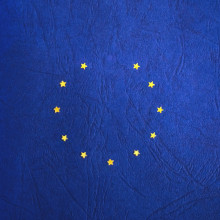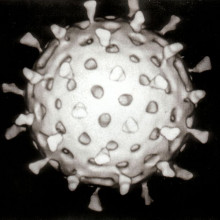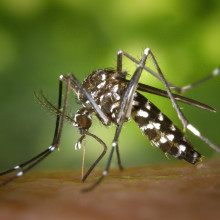We hear a lot about genetic modification and how it’s being used to improve agriculture. But who decides whether modified crops can be grown? Do new gene editing techniques like CRISPR count as GM? And what happens to these regulations when the UK leaves the EU? Plus, our gene of the month comes with a tale behind it.
In this episode

01:09 - GM and Brexit
GM and Brexit
with Huw Jones, University of Aberyswyth
Back in September, Kat Arney went along to a discussion organised by the Royal Society of Biology at the British Science Festival in Swansea, called “Can gene editing save the world?” We’ve covered some of the potential applications of this exciting new technology - commonly known as CRISPR - in previous podcasts, but this time round the researchers at the event were focusing on the legal and ethical implications of gene editing, as well as the practical applications. Rather than diving straight into the implications of new technology - not to mention what happens when the UK leaves the regulatory framework of the European Union - Kat started by taking a step back, speaking to Professor Huw Jones from Aberystwyth University, to find out who decides whether farmers can grow genetically modified crops in the first place.
Huw - If a farmer wanted to cultivate herbicide tolerant crop in Europe, he could only choose something that has been approved by the European Union and at the moment, there aren’t any. So there is no choice. The only one type of food crop – feed crop, actually - that can be cultivated legally in Europe is an insect resistant maize and that’s cultivated in certain areas of Spain and Portugal for feed uses. So, Europe hasn’t authorised – apart from one, MON 810 it’s called - and that was authorised before the current regulatory systems have been put into place. Since 2001, there haven't been any new authorisations for cultivation.
Kat - That seems quite stringent to me, given that there are other countries in the world that are growing genetically modified crops and seem to be okay with it. Is it too strict here in Europe?
Huw - There is a consensus that we have probably one of the most rigorous and risk averse, risk assessment systems, regulatory systems anyway in the world. So, we’re at the top end of the spectrum of how much information we need to carry out a risk assessment. But also, even when the risk assessment is done and EFSA that carries out the risk assessment writes an opinion – it’s called – that states that this crop is the same as the nonconventional counterpart, the politics of Europe then comes into play because it’s the politicians that authorise. EFSA merely carries out an analysis of the risk and then passes that on to the politicians and it’s the politicians that authorise. At the moment, they haven't authorised any new cultivation applications.
Kat - It looks like for now, actual GMOs – so things that have had genes inserted in them using the old transgenic technology - are a bit of a nonstarter in Europe at least. But now, we have these new technologies, genome editing, that seem to be much more precise. What is the regulatory framework around that? What's even the thinking so far?
Huw - Well currently, we don’t know whether the European Union considers these as GMOs or not. Unfortunately, it has to be that zero or one, that black and white choice because there is no opportunity to put them into a third category. Now, they’ve been discussing a range of new biotechnologies and looking at the law of GMOs, and trying to work out whether various types of new biotechnologies are captured within the law or fall outside. This process has been going on for the last 2 or 3 years. But we haven't yet got a final opinion on how the European Commission will see gene editing or other tools like that. But at the same time in other areas of the world, Argentina has just come out with a nice regulatory framework that puts simple genome editing – so genome editing that just causes small single nucleotide polymorphisms - the kind of things you could find in nature if you looked hard enough - they’ve put that outside their GMO laws. The three examples that the USA has considered have deemed those three genome edited examples as not requiring regulation, so they're putting them outside. So there is evidence from the rest of the world that other continents and other competent authorities in those countries are deeming simple genome editing as a non-GMO. Europe, we don’t yet know. But the problem is that if Europe puts them into the GMO category then they’ll have to comply with the same regulatory rigour which again, some commentators say is really the highest in the world. I think that will be disproportionate – the risks are just not there to require such a tough risk assessment for examples of small gene edits that we can find in nature anyway.
Kat - It feels like these genome editing technologies have come on us so fast that it’s only a couple of years since CRSPR was discovered and we’ve had other genome editing techniques that have been around for a couple of years longer than that. For all its wonderful things and its flaws as well, the European Union and the legislative process is not the fastest in the world. Is it that our technology is just speeding ahead, ahead of the legislative process? How do we square this kind of legal circle here ,because it feels as if there’s all this incredible technology coming along, great ideas, things that could be really beneficial, and a huge dinosaur of legal stuff behind it?
Huw - I think we’ve got a two-phase process of change here. What we’ve got in the long run is a recognition that we can no longer regulate using the method of making a change in a plant genome as the thing that puts it into a GMO or a non-GMO camp. So, using this technology or that technology is what we’re talking about now, whereas what we’d really should be focusing on is the change we’ve made in the crop. So, if it’s – let’s say, just take an example, herbicide tolerance you mentioned earlier, if herbicide tolerance has a risk and there are environmental issues with herbicide tolerance then that’s the characteristic that needs the risk assessment regardless of how it’s made. If you make a herbicide tolerant crop through a non-GMO route then at the moment it’s not regulated at all whereas if you make it through a GMO route, it undergoes heavy regulation. What I'm thinking is in the long run, we need to step out from the idea of trying to keep the regulation in check with new technologies of how you do it because they will always develop. There’ll always be changes every few years. Rather take a step back and redefine a regulatory system that focuses on the final product. Is the product new? And if it is, if it’s a new type of food, if it allows different agriculture to be used like herbicide tolerance then that’s the characteristic that needs the risk assessment. As you say, the regulation is a dinosaur. It’s going to take a long time for that to happen. So in the meantime, we need to have some interim steps to tie this over until we can make those bigger changes. I think those have to be perhaps the starting of an intermediate risk assessment category where you haven't got the risks of conventional GMOs but you also would like some sort of regulatory oversight. But it’s proportionate to the risks like in simple genome editing.
Kat - I have to ask the Brexit question. Given that Brexit at least seems to be on the table for the UK to leave the European Union, how does that affect our legal frameworks about our agriculture here in this country?
Huw - Well currently, the EU law surrounding biotechnology is transposed into our laws. So, we are obliged to follow the European law until we leave the European Union. The day that we leave, those laws will be untransposed and we then have the freedom to redefine what biotechnology is and how it’s going to be regulated. So, we have an opportunity to really look at biotechnology and to rewrite the rule book in that sense. But we have also to mindful that even if we were to have let’s say, we had genome edited crops cultivated the UK under our new system then if any of that is exported into the European Union then it anyway will have to comply with the European Union’s biotechnology laws. We have to make sure that we are aware of the fact that we are an island and if things stay on our island then it’s fine. But a lot of food that we cultivate is exported. So we have to then consider the countries that we’re exporting to and we would have to comply with their regulations. So the European Union has this very high levels for risk assessment even for imported crops. Not only for cultivated crops but crops that are imported. So, we would still have to comply anyway with the European Union. It’s not a panacea but it may be for some crops that we know are going to be grown only in the UK and consumed only in the UK then it may be a way forward.
Kat - So British crops for British people may be OK. British crops for anyone else where they don’t have our framework could be tricky.
Huw - Well, it’s no different to how it would be today or how the USA – so the USA, if they're cultivating their GMO corn, they would have to make an application into Europe and get authorisation and then it can be exported. The problem is that the European Union has a zero tolerance policy for unapproved crops. Even if one seed of an unapproved variety ends up getting mixed up in a silo of other seed, even if all of that is approved then if that one seed is detected, the whole shipment gets sent back. So there's a lot of concern that no unapproved varieties get mixed in with the bulk of the approved varieties because it’s a massive risk and it’s a massive financial burden to have a shipment of soy or potatoes turned away from a port because of that accidental mixing.
Kat - Professor Huw Jones from Aberystwyth University.

12:13 - Who benefits from GM?
Who benefits from GM?
with Donald Bruce, Edinethics
As well as the legal restrictions around planting and selling genetically modified crops, there are also ethical and public considerations. Even if it’s legal to grow GM or gene edited food - will the public be prepared to buy it? And who should benefit from this technology? Those are the kind of questions being investigated by Dr Donald Bruce, director of Scottish consultancy firm Edinethics, which focuses on ethical issues in science and technology, speaking here with Kat Arney.
Donald - We set up a working group to look at this issue in the early 1990s. In those days, it was hardly in the media at all. The first example available in the UK was a tomato paste which Zeneca produced, sold by Sainsbury’s and Safeways. They took advice and heard we market this and the message of it all is label it. Give people a choice and tell them why you think it’s important and for them, they saw it as a marketing plus, that this is all the wonderful things they thought will be good. In general, people had a choice. Monsanto in the states were developing genetically modified soy and maize which came over as imports. They didn’t do any labelling. They said it’s been through the Food and Drug Administration and all the processes it has to do in the states. If we label it, that means there's something wrong. In the UK, a label meant more, that it’s something informational. They did not make any system for segregating or labelling. I mean, it’s not just them. I mean obviously, it’s all the milling or other processes that occur. The result was that people suddenly discovered they were eating GM food without knowing it. Maize and soy goes through what counts of the food processing and then in February 1999, there was a concerted campaign by a number of NGOs, development agencies, a couple of the major newspapers got together and said, “We want to freeze a moratorium on GM applications. We don’t know enough about this.” They had a series of things in the press, one day after another, after another over 5 days, a scandal of some sort. At the end of that, everyone said, “Oh Gosh! Is it really that bad?”
Kat - I remember this. This is like “Franken foods” kind of stuff.
Donald - Green Peace got one of their absolutely extraordinary pieces of soundbite of Frankenstein foods. It was a joke, but the stigma stuck. So the result was, people said, “Hang on a moment. What's this stuff for?” Well, the tomato paste was obvious. It was slightly cheaper and it tasted better because they used less squashy tomatoes because they switched a gene off that made tomatoes squashy. So in fact, it was actually more energy efficient to produce it and it costs less. And so, I asked a supermarket manager in Edinburgh sold this stuff. He said, “We had students buy it quite a lot because it’s cheaper.” So there was a tangible benefit. With the stuff Monsanto are producing, there's no tangible benefit at all. I mean, lots of things do to its environment and farmers but it didn’t affect the average consumer and there were these concerns about risk, “Gosh! Is this going to harm my child? If I eat the stuff, do they know enough?”
Kat - “Am I going to get this DNA and all these sort of things?”
Donald - Or something, yeah. And so, the consequence of that was, “If there's no benefit to me, there could be a risk. I can't have any choice here with this matter.” In a sense, it’s pretty obvious you think, “We don’t want this” which is a sort of fairly natural reaction which didn’t happen in the states. In North America, they trusted their regulators a lot more. In the UK, we had only unfortunately, just had the mad cow diseases where the government is saying it’s safe to eat British beef and then the CJD Surveillance Unit in Edinburgh found actually there was a link. And so, “You told us it was okay over British beef and CJD. How do we know it’s okay over GM?” So, regulators have very little trust at that point. So, it was a very different context.
Kat - You say that at the beginning in the US, they were okay with it and now, we’re seeing a bit of a backlash, in particular social media people being very worried about GMs and sort of fighting against them and arguing for compulsory labelling again when there was none. Now we’re moving into a potentially new phase of genetic modification of crops of agriculturally important organisms. How should we think about that from the sort of ethical point of view from the risks?
Donald - Genome editing is making the claims that GMOs were making – people promoting GMOs were making - 20 years ago, this is much more precise than the technologies we’ve had before. Well, GMOs as we’ve had them are more precise than selected breeding where somebody once said, “Cross the best and hope for the best.” So it was more precise than that. But it wasn’t that precise. Here, we have a technology that has a great deal more precision and so, I think the claim is a genuine one. People talk about off target events where you insert your GM or do the modification in more places than you intended to. Is that a significant risk? I think at this stage, people don’t know enough to be really quite sure but the indication is looking pretty good that that’s a very small risk. The question is, is it significant enough?
Kat - But then there's off target risks with GMO, with selective breeding, and with the kind of mutation techniques that people use already.
Donald - Well, the Food Standards Agency in the UK said there was no particular intrinsic reason why GM food should be any more or less safe than conventionally grown or organic food. As such, the technique doesn’t make it more or less unsafe. So, I think it’s the same with the part of genome editing. You should not look at this as being something that’s intrinsically dangerous. But one of the problems is, people tend to regard some of GMO issues as if it was radioactive substances. I used to be in the nuclear industry.
Kat - Scary! Scary! Bad! Bad! Bad!
Donald - Well, more of a sense of something that is insidious and might get to me as it were if I eat it. It’s a really different concept to that. I think that there are a number of perception issues here, but I think for those for whom just tinkering with our genes is an issue, that will not change people’s viewpoints. If what people are worried about is switching genes across species then genome editing may address that question. But we’re still going to have to regulate some of the more advanced forms of this. Particularly for having multiple additions then it will be something like GMOs. But the precision hopefully, gives you a better chance of addressing some of the concerns of risk.
Kat - Finally, is there one thing or even one fact that would help people to think about this in a clearer way and maybe avoid the sort of the “GMO panic” that we’ve seen?
Donald - I don’t think there is any one factor that would do that because the way people constructed their own view of risk is a complex affair and there's no one simple message to give because it depends how you see it and you got to work with that. It’s not something which has a simple answer, but I think one very significant fact is if you made genome edited foods or other products that people saw an actual benefit to then that has something substantial to weigh against whatever risk perception they’ve got.
Kat - So, that’s a benefit for them directly, for people eating this stuff.
Donald - Yes. So it could be towards a health issue. It might be something for a developing country. You might think there's a pest that’s unique to Uganda or somewhere. If you could use something with the local crop that they have, wouldn’t that be valuable? So, it might be a whole range of things that people saw it as a benefit or disease resistance in pigs. If people saw a benefit coming from it then that’s something tangible to weigh against whatever risks they will perceive. I think it’s really up to those promoting the technology to say, “We will only really develop upfront the things that are going to be a benefit” and not just take things that were just useful for seed companies but nobody else.
Kat - Donald Bruce from Edinethics.

20:35 - Ancient viruses get older
Ancient viruses get older
A new study from scientists at Oxford University, published in the journal Nature Communications, suggests that retroviruses - a family of viruses that includes HIV - are several hundred million years older than previously thought.
According to lead researcher Dr Aris Katzourakis, it was previously thought that these viruses - which can embed themselves in the genome and lie dormant - may have arisen only 100 million years ago, making them young whippersnappers in evolutionary terms.
Because viruses don’t fossilise, scientists have to figure out their age by looking at the viral DNA across many different species which separated a long time ago - these can be thought of as genetic fossils rather than physical ones.
By comparing the remnants of DNA of so-called "foamy" retroviruses across species as diverse as mammals, fish and amphibians, Katzourakis and his team conclude that retroviruses are almost half a billion years old, and evolved together in a kind of arms race with the evolution of immune responses in their hosts.
Probing how animal and viral genomes have evolved hand in hand over millions of years is enabling researchers can gain a deeper understanding of immune responses to these invaders and leading to more effective antiviral treatments in the future.

Driving genes
with Tony Nolan, Imperial College London
Now it’s time to look at another application of genetic engineering - something known as a gene drive, which can force particular genetic modifications through populations. Kat Arney asked Dr Tony Nolan from Imperial College London to explain what it’s all about.
Tony - Well a gene drive is a genetic element that is able to balance its inheritance with each generation. Whereas a normal gene, one copy of a gene in an organism with two chromosomes had over 50 per cent chance of being inherited. A gene drive will increase that to some level above 50 per cent. In the best case, to 100 per cent and therefore, with respect to a normal gene that will double in frequency with every generation.
Kat - So, instead of half the family have it and then a quarter of the grandchildren have it, it’s in everything and everything is likely to inherit this particular variation.
Tony - Not immediately but with each generation, it would increase in frequency, up to a point where most of the organisms in the population will have it.
Kat - This sounds really useful, but what can you actually use it for?
Tony - Well, there are different potential uses of it. One of them is to introduce with the gene drive some sort of cargo that affects the population in a way that’s useful so we work on mosquitoes. One way would be to introduce some target that interferes with the mosquitoes’ ability to transmit disease such as malaria. Another way is to introduce some genetic change that affects the mosquitoes’ fertility. So, as the gene drive element spreads through the population, at the same time, it’s actually damaging the potential of that population to reproduce. And therefore, you reduce the number of mosquitoes. And therefore, you reduce their overall potential to transmit disease.
Kat - So you could basically use it to force a modification through a whole population or effectively eventually make a population extinct?
Tony - In the case of mosquitoes which is what we work on, yes, the idea of localised suppression and in some cases, that could be local eradication of the mosquito.
Kat - This sounds in some ways a good idea. I hate mosquitoes. They bite me. They're awful. They spread disease. Are there risks to eradicating an entire population like that?
Tony - Well, that’s something that we’re obviously keenly aware of. What I would say is with the gene drive, it’s a species-specific tool so it will be contained within that species and any attempt to modify on a population level needs a thorough evaluation of the risks and benefits. You need to consider some of these technologies against more conventional approaches such as insecticide spraying or general attempts to reduce mosquito numbers which are nonspecific.
Kat - So actually, if you're spraying all the insects in an area, that’s doing more harm than just trying to get rid of the mossies?
Tony - Right. Compared to a gene drive that is species-specific, in that case, you get rid of all mosquitoes. You get rid of a wide range of different insects so you’ve got a much broader acting ecological consequence.
Kat - Let’s go into a little bit more detail about, how does the gene drive actually work? What's going on at the sort of nuts and bolts level?
Tony - Gene drives can take several forms but the one that we’re developing and the one that’s making the most impact at the moment relies on a very specific nuclease. So a nuclease is a DNA cutting enzyme that will cut the very precise sequence on one of the chromosomes of your organism and it will cause a double stranded break so you'll have a broken chromosome. The way it’s designed, that broken chromosome uses the copy of the nuclease as a template to repair. So the nuclease gets copied across from one chromosome to another. And so, instead of being just only on one chromosome, it’s now present on both chromosomes. And therefore, is inherited among all offspring.
Kat - And along with that, that would be modification for sterility or for disease resistance.
Tony - Right. Along with that, there will be some effects.
Kat - And finally, I would personally like to see an end to all mosquitoes in the world, but would there be environmental consequences for getting rid of mossies? What about the things that eat them?
Tony - Well, in the specific case of malaria, malaria is transmitted only by a handful of mosquitoes of a genus called Anopheles and that’s a handful of mosquito species amongst several thousand, 3,000 or 4,000 species of mosquitoes. So this would be a very targeted approach and would be removing specifically those mosquitoes capable of transmitting malaria. So there would still be plenty of mosquitoes around where it’s successful. And furthermore, as far as we know, there are no dedicated specialist predators on this species of mosquito. But of course, the technology is in very early stages. It’s got a huge amount of potential but it’s going to be part of the risk assessment. It’s to fully evaluate the ecological risks, and if there are any risks, they will be taken into consideration before applying this technology.
Kat - Tony Nolan from Imperial College London.

27:28 - Gene of the Month - Dachshund
Gene of the Month - Dachshund
First discovered in fruit flies in 1994, Dachshund’s main job is to work together with a gene called hedgehog, telling cells in the developing insect eye to become light-sensitive retinal cells, rather than becoming cuticle cells - the insect equivalent of skin. But its name actually comes from another function - helping to define the correct pattern of segments in a fly’s legs. Without Dachshund, fruit flies have unusually short legs - just like those diminutive canines. The mammalian version of Dachshund is also active in the eye and limbs, but it’s also switched on in the brain and some other structures. The human Dachshund gene also seems to act as a tumour suppressor, stopping cells from growing out of control and forming cancers, and faults in the gene have been found in some types of human cancer, including lung, pancreas and liver tumours.










Comments
Add a comment